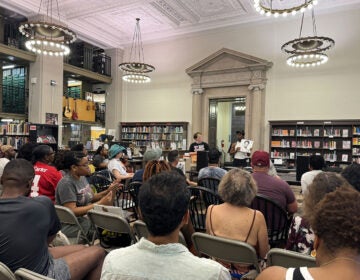Prelude to a pivotal year: Philadelphia Orchestra members warm up for harmonious season
ListenThe Philadelphia Orchestra is putting on its top hat and brushing off its tails for the opening of the 2012-2013 season.
We caught up with a handful of musicians to see how they are getting ready.
The Philadelphia Orchestra is putting on its top hat and brushing off its tails for the opening of the 2012-2013 season at the Kimmel Center.
Having just emerged from bankruptcy, with a $25 million fundraising gap, the Orchestra Association is striding into the new season with ambitious enthusiasm — much of it is propped up by the arrival of its new music director, Yannick Nézet-Séguin. The young, charismatic conductor from Montreal is expected to enliven the podium, electrify the musicians, and attract patrons to Verizon Hall.
We caught up with a handful of musicians to see how they are getting ready.
In Maurice Ravel’s “Bolero,” the instruments of the orchestra take turns on its signature melody. About half way in, when it’s the trombone’s turn to launch into the B-flat riff, Matthew Vaughn starts to sweat.
“It’s a high note for the trombone,” said Vaughn. “Your muscles are engaged and there’s a lot of room for error.”
The associate principal trombonist in the Philadelphia Orchestra stays game-ready by forcing himself to relax. He regularly does simple yoga exercises by putting his body into a taut strain while breathing normally. It keeps him in the habit of moving air gracefully under pressure.
“As a brass player, it is a real physical thing,” said Vaughn. “It is not common to have someone in the orchestra who is 80 years old as a brass player because they just don’t sound good.”
Vaughn is looking to stay in the game for the long haul, with a lot of Boleros still ahead of him.
“The cellists have been known to take wagers on whether or not you hit that first B flat,” said Vaughn. “So if I get through that first B flat, at least I can say, ‘Yes! I won this time!’ and relax a little bit.”
Traditionally, oboe is of particular note
When you attend a Philadelphia Orchestra performance, Richard Woodhams’ oboe always forms the first note you hear.
It’s his instrument crying out the perfect A, to which all the other instruments tune. It’s an orchestral tradition dating back centuries.
“The oboe was so affected by temperature and could not adjust. So whatever the pitch the oboe was at, everyone was supposed to tune to that,” said Woodhams, the principal oboist since 1977.
That’s not the case anymore; his note stays pure with the help of a digital tuner he keeps in his kit bag.
Nevertheless, Woodhams keeps at least a couple traditions alive.
“I am the very lucky inheritor of a great tradition,” said Woodhams. “People may not know about it in Philadelphia. It’s one of the finest exports of Philadelphia, which is the Philadelphia school of oboe playing, founded by a Frenchman named Marcel Tabuteau.”
Considered one of the 20th century’s finest musicians, Tabuteau was the first principal oboist with the Philadelphia Orchestra and one of the original instructors at the Curtis Institute of Music. He changed the way the instrument was played.
Conjuring the sublime tone
“He took reeds to another level,” said Woodhams. “Before that, you could have a thin sound that would be flexible, or you could have a dark warm tone that was inflexible. Tabuteau found a way to have a dark warm tone that is also very flexible.”
Woodhams spends 10 to 20 hours a week carefully whittling bamboo into reeds. With an extremely sharp stainless steel blade, he scrapes the reed into a slight bulge tapered to an edge less then the width of a human hair. Precision is everything. The slightest shaving can transform a sick goose into something warm and round — the sound aged bourbon would make if it could hum.
“There is a lot of mystery involved in reed making — hocus-pocus, legend, and everything else — it is a very big part of playing the oboe,” said Woodhams. “When things go well, it is actually fun because it is the closest thing to being a medieval alchemist.”
WHYY is your source for fact-based, in-depth journalism and information. As a nonprofit organization, we rely on financial support from readers like you. Please give today.




